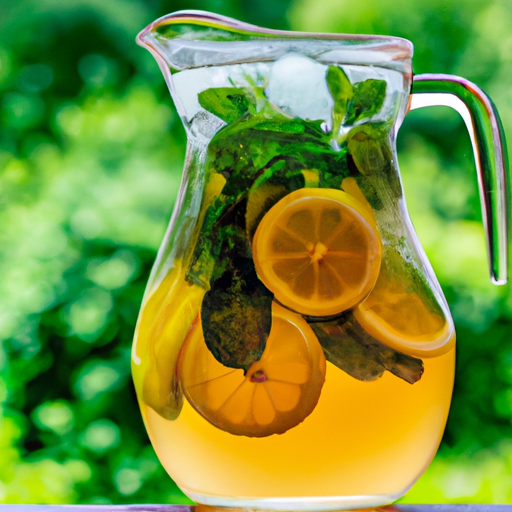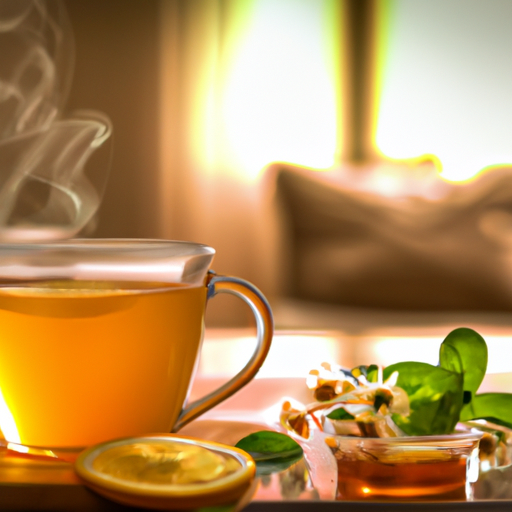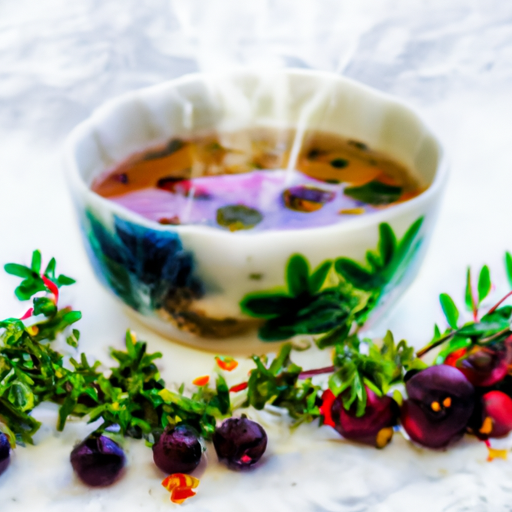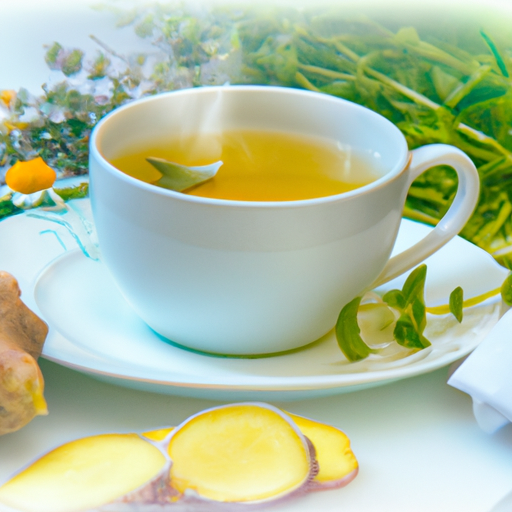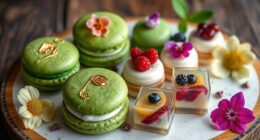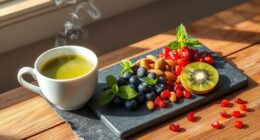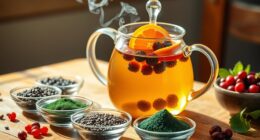Making the perfect herbal iced tea is like creating a refreshing oasis in a desert of thirst. As a tea enthusiast, I have dedicated countless hours to perfecting this art and I am excited to share my knowledge with you.
In this article, I will guide you through the steps to achieve herbal iced tea perfection.
First and foremost, selecting the right herbal tea blend is crucial. With a myriad of options available, you can explore flavors ranging from soothing chamomile to invigorating peppermint.
Once you have chosen your blend, it’s time to brew your tea. Boiling water, steeping time, and tea-to-water ratio all play pivotal roles in extracting the optimal flavor.
After brewing, it’s essential to sweeten your tea to taste. Whether you prefer honey, agave, or a touch of sugar, the choice is yours. To elevate the flavor profile even more, consider adding flavor enhancements such as citrus slices or fresh herbs.
Finally, chill your concoction to perfection and serve over ice. The result? A tantalizing elixir that will quench your thirst and invigorate your senses.
So, grab your teapot and embark on this herbal adventure. Get ready to experiment, discover new flavors, and most importantly, stay hydrated.
Key Takeaways
- Selecting the right herbal tea blend is crucial for making a perfect herbal iced tea.
- Brewing the tea with the right water-to-tea ratio and steeping time is important for desired strength and flavor.
- Adding natural sweeteners like honey or maple syrup and flavor enhancements like citrus slices or fresh herbs can enhance the taste of herbal iced tea.
- Experimenting with different combinations of herbs, fruits, and spices can create unique and delightful flavors in homemade herbal iced tea.
Choose Your Herbal Tea Blend
Now, let’s dive into the exciting world of choosing your very own herbal tea blend for the perfect refreshing iced tea experience! When it comes to choosing herbal tea blends, the options are endless. The first step is to explore different flavors and find the ones that appeal to your taste buds. Whether you prefer fruity, minty, or floral notes, there’s a blend out there that’ll satisfy your cravings.
One popular choice is a fruity blend, such as hibiscus and berry. This combination offers a vibrant and tangy flavor that’s perfect for a summer day. If you enjoy a more soothing and calming taste, chamomile and lavender might be the perfect blend for you. The floral aroma and gentle flavors create a relaxing experience that can help you unwind.
Another option to consider is a minty blend, like peppermint and spearmint. This refreshing combination not only cools you down on a hot day but also invigorates your senses. The crisp and clean taste’ll leave you feeling refreshed and rejuvenated.
Now that you’ve chosen your herbal tea blend, it’s time to move on to the next step: brewing your tea.
Brew Your Tea
To brew your tea, start by boiling water in a kettle or pot. Once the water reaches a rolling boil, carefully pour it over the tea bags or loose herbs in a teapot or mug.
Allow the tea to steep for the recommended time, adjusting the steeping time based on your desired strength. The longer you steep, the stronger the flavor will be.
Boil water and steep the tea bags or loose herbs
First, you’ll want to grab those tea bags or loose herbs and boil some water because clearly you have all the time in the world to wait for it to cool down. Once the water is boiling, remove it from the heat and add the tea bags or loose herbs. Let them steep for about 5-10 minutes, depending on your taste preference.
During this time, the water will absorb the flavors and beneficial compounds from the herbs, enhancing the taste and potential health benefits of your herbal iced tea. To ensure a stronger flavor, you can adjust the steeping time accordingly. The longer you steep, the stronger the flavor will be.
Once the desired strength is achieved, it’s time to move on to the next step of adjusting the steeping time for desired strength.
Adjust steeping time for desired strength
For a bolder and more robust flavor, I recommend adjusting the steeping time of your herbal tea. The longer you allow the tea bags or loose herbs to steep, the more rich and aromatic essences they will release.
Steeping for an extended period of time allows the flavors to fully develop, resulting in a more intense and satisfying cup of iced tea. Keep in mind that different herbal teas have different recommended steeping times, so it’s important to consult the packaging or a trusted source for guidance.
Adjusting the steeping time can enhance the natural flavors of the herbs and create a more personalized taste experience. Once you have achieved your desired strength, you can move on to the next step of sweetening your tea to taste.
Sweeten to Taste
Indulge in the rich flavors of your herbal iced tea, adding just the right amount of sweetness to satisfy your taste buds and bring a touch of bliss to your day.
The beauty of herbal tea lies in its versatility, allowing you to personalize it with various sweeteners options. When it comes to sweetening your herbal iced tea, natural sweeteners are a great choice. They not only enhance the taste but also provide additional health benefits.
Here are some natural sweeteners you can consider:
- Honey: This golden liquid not only adds sweetness but also brings a unique floral flavor to your tea.
- Stevia: Derived from the stevia plant, this zero-calorie sweetener is a great option for those watching their sugar intake.
- Maple Syrup: Adding a rich, earthy sweetness, maple syrup is a delicious alternative to traditional sweeteners.
Experiment with these natural sweeteners to find the perfect balance that suits your palate. Remember, the key is to add sweetness without overpowering the herbal flavors.
Once you’ve sweetened your tea to taste, it’s time to move on to the next step and explore flavor enhancements.
Add Flavor Enhancements
When it comes to adding flavor enhancements to herbal iced tea, fresh fruits and herbs are the way to go. They not only add a burst of freshness but also infuse the tea with delicious flavors. I personally love adding citrus slices or ginger to give my tea a zesty twist that enhances its overall taste.
Fresh fruits and herbs for added freshness and flavor
To enhance the freshness and flavor of your herbal iced tea, try adding a medley of fresh fruits and herbs. This not only adds visual appeal but also infuses your drink with natural sweetness and additional health benefits.
Here are three reasons why incorporating fresh fruits and herbs into your tea is a great idea:
-
Fruit infused water: By adding fruits like berries, citrus slices, or melons to your herbal tea, you create a refreshing and thirst-quenching beverage that’s packed with vitamins, minerals, and antioxidants.
-
Benefits of herbal tea: Herbal tea is already known for its numerous health benefits, such as boosting the immune system and aiding in digestion. Adding fresh fruits and herbs takes these benefits to the next level, as they add their own unique set of vitamins and minerals.
-
Freshness and flavor: The natural flavors of fresh fruits and herbs complement the herbal tea perfectly, creating a harmonious blend of tastes. The vibrant colors and fragrant aromas also enhance the overall sensory experience.
For a zesty twist, citrus slices or a touch of ginger can be added. This adds a refreshing kick to your herbal iced tea without overpowering the delicate flavors.
Citrus slices or ginger for a zesty twist
After discussing the benefits of using fresh fruits and herbs in herbal iced tea, let’s now explore another way to add a zesty twist to your beverage.
One option is to include citrus slices or ginger in your tea. Citrus slices, such as lemons or oranges, can infuse the water with a refreshing and tangy flavor. Ginger, on the other hand, adds a hint of warmth and spice.
To incorporate these ingredients, simply slice the citrus fruits or grate the ginger and add them to your tea while it steeps. The result will be a delightful blend of flavors that complement the herbal notes of the tea.
To enhance the sweetness, you can also add a drizzle of honey to your citrus-infused herbal tea.
Now that we’ve explored the various ways to infuse flavors, let’s move on to the next section and discover how to chill and serve our perfect herbal iced tea.
Chill and Serve
Once the herbal iced tea is perfectly chilled, it’s time to serve and enjoy its refreshing flavors. There are different ways to chill herbal iced tea, depending on your preference and time availability. One option is to place the pitcher of brewed tea in the refrigerator for a few hours until it reaches the desired temperature. Another method is to pour the hot brewed tea over a glass filled with ice, allowing it to cool down quickly. This method is great if you’re in a hurry or want to enjoy your tea immediately.
When it comes to serving herbal iced tea, presentation is key. To enhance the visual appeal, consider adding garnishes such as fresh mint leaves, lemon wedges, or colorful fruit slices. These additions not only make the drink more visually appealing but also add a burst of flavor. To make it even more enticing, you can create a beautiful table setting with a 2 column and 4 row table. In the first column, place various flavors of herbal iced teas, such as hibiscus, chamomile, or lavender. In the second column, pair each tea flavor with suggested garnishes and serving suggestions. This table will surely evoke a sense of excitement and anticipation in your guests.
Now that your herbal iced tea is chilled and ready to serve, it’s time to experiment with variations.
Experiment with Variations
When experimenting with variations in herbal iced tea, I love trying different combinations of herbs and fruits to create unique flavors.
For a refreshing twist, I often infuse my tea with spices like cinnamon or ginger, which add warmth and depth to the taste.
Additionally, I enjoy exploring other unique ingredients such as citrus peels or edible flowers, which bring a delightful complexity to the overall beverage.
Try different combinations of herbs and fruits
To elevate the flavor profile, experiment with various herb and fruit combinations when making the perfect herbal iced tea. By combining different herbal tea flavors with unique fruit and herb combinations, you can create a refreshing and delicious beverage that’ll tantalize your taste buds.
Here are three combinations to try:
-
Chamomile tea with fresh peach slices and a sprig of mint. This combination creates a soothing and floral drink with a hint of sweetness.
-
Green tea with sliced strawberries and basil leaves. The combination of the earthy green tea, juicy strawberries, and aromatic basil adds a burst of freshness to your iced tea.
-
Hibiscus tea with orange slices and rosemary. The tartness of hibiscus tea pairs perfectly with the citrusy flavors of oranges, while the addition of rosemary adds a unique herbal note.
To infuse your tea with spices or other unique ingredients, continue experimenting with different combinations to find the perfect blend that suits your taste preferences.
Infuse your tea with spices or other unique ingredients
Spice up your tea by infusing it with unique ingredients like cinnamon or ginger for an extra kick of flavor. The addition of spices can take your herbal iced tea to the next level, creating a truly tantalizing experience for your taste buds. When it comes to spices infusion, the possibilities are endless. You can experiment with cloves, cardamom, or even star anise to add depth and complexity to your beverage. Not only do these spices enhance the flavor, but they also offer various health benefits. Cinnamon, for example, is known for its anti-inflammatory properties, while ginger aids digestion. To help you get started, here’s a handy table showcasing some interesting combinations of herbs, fruits, and spices that you can try in your herbal iced tea:
| Herb/Fruit | Spice |
|---|---|
| Mint | Lime |
| Rosemary | Lemon |
| Lavender | Basil |
| Peach | Vanilla |
Now that you have a range of options to experiment with, it’s time to enjoy and stay hydrated.
Enjoy and Stay Hydrated
I love sipping and savoring my homemade herbal iced tea during the summer season. It’s not only a refreshing beverage, but it also helps me stay hydrated in the heat.
With each sip, I can taste the carefully selected herbs and feel refreshed from the inside out.
Sip and savor your homemade herbal iced tea
Relax and indulge in the refreshing goodness of your homemade herbal iced tea. Experimenting with different flavors is one of the joys of making your own tea.
Whether you prefer a classic combination like mint and lemon or a more adventurous blend of lavender and chamomile, the possibilities are endless. Not only does herbal iced tea taste delicious, but it also offers numerous health benefits.
Depending on the herbs you choose, your tea can provide a natural source of antioxidants, promote digestion, and even help with relaxation and stress relief. So take a moment to sip and savor your creation, knowing that you’re nourishing your body with a beverage that’s both delicious and beneficial.
Now, let’s explore how to stay refreshed and hydrated throughout the summer season.
Stay refreshed and hydrated throughout the summer season
Now that you’ve learned how to sip and savor your homemade herbal iced tea, let’s talk about staying refreshed and hydrated throughout the summer season. As the temperature rises, it’s important to find a beverage that not only quenches your thirst but also provides health benefits.
Herbal iced tea is the perfect solution. Not only is it delicious and refreshing, but it also offers a myriad of benefits for your body.
Here are three reasons why herbal iced tea should be your go-to summer drink:
-
Hydration: With its high water content, herbal iced tea helps keep you hydrated, which is essential during hot summer days.
-
Cooling effects: Certain herbal teas, like peppermint or hibiscus, have natural cooling properties that can provide relief from the scorching heat.
-
Health benefits: Different herbs used in herbal tea have various health benefits, such as improving digestion, boosting the immune system, and reducing inflammation.
So, why not try out different herbal tea recipes this summer and enjoy both the taste and the benefits it brings? Cheers to a refreshing and healthy summer!
Frequently Asked Questions
Can I use regular tea bags instead of herbal tea bags for making herbal iced tea?
Using regular tea bags for herbal iced tea is possible, but there are pros and cons. Regular tea bags may not have the same health benefits as herbal tea bags, but they can still provide a refreshing flavor.
How long should I brew the herbal tea for the best flavor?
For the best flavor, I recommend steeping herbal tea for 5-7 minutes. This allows the flavors to fully develop without becoming overpowering. Just like a good marinade, the longer you steep, the more robust the taste.
Can I use artificial sweeteners instead of sugar to sweeten my herbal iced tea?
Yes, you can use artificial sweetener alternatives to sweeten your herbal iced tea. However, it’s important to note that artificial sweeteners may have potential health impacts that you should consider.
Are there any health benefits associated with drinking herbal iced tea?
Drinking herbal iced tea offers numerous health benefits. It can boost immunity, aid digestion, and reduce inflammation. The best time to enjoy this refreshing beverage is in the morning or after a meal.
Can I add milk or cream to my herbal iced tea for a different taste?
Using milk or cream in herbal tea can provide a creamy and rich flavor. However, it may dilute the herbal taste and add extra calories. Consider trying it, but be mindful of the potential drawbacks.
Conclusion
In conclusion, crafting a delightful herbal iced tea is a journey of taste exploration and satisfaction. By carefully selecting a blend of herbs, brewing the tea to perfection, and adding just the right amount of sweetness and flavor enhancements, you can create a beverage that will invigorate and quench your thirst.
Remember to experiment with different variations to find your personal favorite. So, indulge in this delightful elixir, and let its refreshing essence keep you hydrated in the most exquisite way possible.

